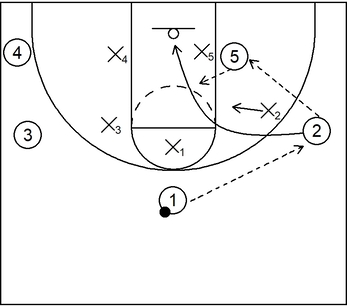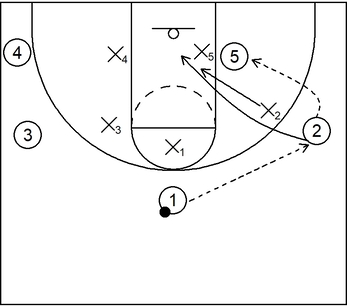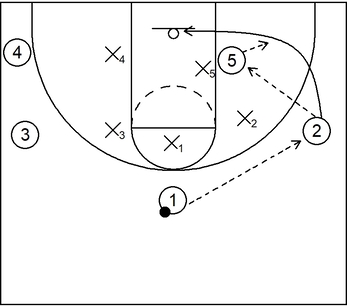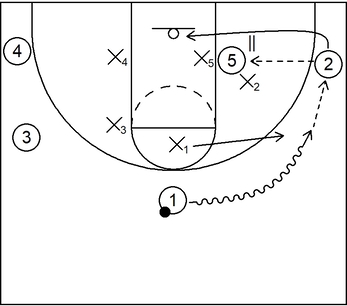What is the Laker cut in basketball
The Laker cut comprises action that occurs when an offensive player in possession of the basketball, typically near the wing, passes it to another player near the low post, immediately cuts toward the basket, and then possibly receives the ball again from that same low post player for a scoring opportunity.
The Laker cut also implements basic pass and cut action, which occurs because an offensive perimeter player executes a pass and quickly cuts, for this case, toward the basket.
Furthermore, the Laker cut institutes give and go action as well, especially upon completion of the pass that results in scoring points at the rim.
What is a brief history of the Laker cut
In terms of a brief history, the Laker cut derives its name from the NBA team known as the Los Angeles Lakers.
What’s more, the Laker cut was utilized during the Showtime Era of the Lakers’ dynasty, which won five championships; notably with Hall of Famers Kareem Abdul-Jabbar, Magic Johnson, James Worthy, Jamaal Wilkes, and Bob McAdoo among others.
What are the two basic types of Laker cuts
The two basic types of Laker cuts are the high side Laker cut and the low side Laker cut.
High side Laker cut
The high side Laker cut occurs when the offensive player moves through the lane area, ideally by moving at a slight angle near the high post elbow prior to reaching the basket.
Also, the high side Laker cut is generally preferred or recommended over the low side Laker cut most of the time, mainly because it promotes good basketball spacing and it disrupts the overall scheme of the defensive team.
Essentially, the spacing is important because if the offensive perimeter player executes the high side Laker cut too close to the low post player that receives the ball, then the perimeter defender that is initially guarding the cutter could either temporarily double team the low post or simply dig at the ball.
As a result of the double team or defensive dig, that could lead to a steal and/or subsequent turnover.
In more simple words, a Laker cut that is too close, specifically on the high side, gives the perimeter defender an opportunity to guard the ball (i.e. the low post player) and their original assignment (i.e. the perimeter player) at the same time.
This is detrimental and not feasible at all, particularly for set plays or strategies of basketball offense that includes the Laker cut.
As it relates to disrupting the defense, whenever an offensive player dribbles or cuts through the lane/paint area towards the basket, that same offensive player is automatically moving into defensive gaps.
In other words, the offensive player would be in between one or more defenders that would be on either side of the court.
This is dangerous for the defense in general because if that offensive player already has the ball or could potentially receive the ball, then that offensive action could lead to points being scored.
For the high side Laker cut in particular, when an offensive player cuts through the lane and receives the ball, as mentioned previously, this could result in that same player scoring points.
However, in certain instances, to mitigate or even eliminate that scoring opportunity, one or more defenders could collapse into the lane.
The drawback for the defense in that regard though is that one or more other offensive players would be left open near the perimeter areas of the court.
So, the high side Laker cutter could then execute a kick pass to one of those perimeter players, which could then lead to an alternative scoring opportunity in the form of a three-point jump shot.
It should also be noted that in some cases, the defense may even collapse following the high side Laker cut before the cutter even receives the ball.
If that occurs, then the low post player might be able to throw a skip pass to an offensive teammate on the weak side, which could still lead to a scoring opportunity.
Simply put, the Laker cut, especially on the high side, is probably one of the most effective basketball cuts, although it is very basic action.
Low side Laker cut
The low side Laker cut occurs when an offensive player moves towards the basket but adjacent to the baseline, which is also on the low side of the frontcourt, hence the name.
The low side Laker cut is usually not given priority over its high side counterpart but in certain instances, it would be more practical and logical in terms of producing a potential scoring opportunity.
For example, if an opposing team and more specifically, an opposing coaching staff emphasizes a no middle defense philosophy, then the moment that the ball gets into the hands of the low post player on the strong side, the low post defender as well as the cutter’s defender near the perimeter will play defense on the high side of those respective offensive players.
When that happens, it would make sense for the offensive perimeter player to execute a low side Laker cut because that side would be more open than the middle area.
Another instance that a low side Laker cut might be a viable option is when a perimeter player is initially in the corner and their respective defender turns their head to look at the ball or even worse, they attempt to help one pass away by digging at the ball or performing a double team.
As a result of that, the offensive player that was initially in the corner could Laker cut on the low side, receive the ball, and score at the basket.
This option could be favorable because the cutter would be below the overall defense, which also means it would be challenging for their own respective defender or any help defenders to tag or play switch defense in enough time prior to the field goal attempt at the rim.
What are basic diagram examples of the Laker cut
Example 1

This is a basic example of a standard Laker cut that could produce a quick scoring opportunity near the basket.
As it relates to standard basketball positions, 1 is the point guard, 2 is the shooting guard, 3 is the small forward, 4 is the power forward, and 5 is the center.
In terms of the initial offensive set-up, 1 is at the top, 2 is on the right side wing, 3 is on the left side wing, 4 is in the left side corner, and 5 is on the right side low post.
In terms of the defensive set-up, X1 drops back to protect the nail, particularly after 1 executes the pass.
Moreover, it is not shown on the diagram but X1 should also jump to the ball following the pass of 1, mainly to prevent a face cut by 1.
Next, X2 does not sag too far away from 2 but X2 also does not play too closely with maximum defensive pressure as well.
X3 and X4 are the weak side defenders and therefore should slide towards the lane line near the weak side high post and low post respectively.
X5 is the primary on-ball defender once 5 receives the ball and simply plays behind the offensive low post player with standard man to man defense.
In other words, X5 is not overplaying to take away the baseline or attempting to prevent 5 from dribbling the ball towards the middle of the paint.
To begin the offensive action, 2 receives the ball from 1 and following that, 5 receives it from 2. Next, 2 executes the high side Laker cut into the middle of the lane.
This particular action could be even more potent if X2 were to turn their head to look at the ball, which would then allow 2 to stay open for at least a second longer than otherwise.
From there, 2 could then receive the ball again from 5 and score at the rim with a layup or dunk.
What also makes this action useful is that if off-ball defenders attempt to help on the Laker cut, then this could lead to subsequent defensive disruptions.
For example, if X1 drops back further in the lane to tag or slow down the Laker cut action, then 1 could cut to the previously vacated right side wing and then receive the ball from 5, which could result in a potential three-point jump shot.
That could possibly work because X1 would then be too far away and most likely would not be able to execute a proper defensive closeout on 1.
What’s more is that even if X1 is able to closeout with moderate or excellent effect, 1 could counter with fake and drive action, which would consists of a pump fake immediately followed by an drive towards the rim.
As another example of why the Laker cut is practical against off-ball help defense, let’s say that either X3 or X4 slides into the lane to tag the cutter or protect the basket, respectively.
In those moments, 5 could execute a skip pass to 3 or 4, which could also lead to potential three-point shots or fake and drive action.
Besides that, if 2 receives the ball but X4 slides into the paint as the low man to take away the potential uncontested layup, then 4 could receive the ball from 2, which could also result in a possible jump shot.
Example 2

This is a basic example of a standard Laker cut that demonstrates why an issue could arise when the offensive perimeter player does not cut with an adequate amount of spacing, specifically on the high side.
Notice that after 5 receives the ball via the post entry pass, 2 executes a high side Laker cut that has little to no curvature or cutting angle.
Moreover, notice that even if X2 turns their head to look at the ball after the initial pass, it will be of minor or no effect because X2 could still recover and guard X2 more easily.
Additionally, as 2 cuts through the lane, X2 would even have an opportunity to temporarily double team the ball or at least dig down for a possible steal.
Ultimately, the pathway of this high side Laker cut variation is too close to the low post player and is therefore, generally not recommended for practical purposes.
Example 3

This is an example of a Laker cut on the low side that could be useful in certain situations. For this situation, notice that X2 and X5 are both overplaying on the high side.
As a result, once 5 receives the ball from 2, that overplay action gives 2 the option to perform the Laker cut on the low side near the adjacent baseline.
From there, 2 could receive the ball from 5 via a pass (or possibly a handoff) and score at the rim by way of a layup or dunk.
Example 4

This is an example of a low side Laker cut that is probably not as common because the cutter begins near a corner.
To start the action, 1 executes a dribble entry towards the right side wing. Following that, 2 receives the ball from 1 and immediately throws the ball to 5 via the post entry pass.
From there, X2 makes a mistake by helping one pass away and attempts to dig down on the ball while it is in the low post.
As a result, 2 takes advantage by utilizing the low side Laker cut towards the basket.
Next, 2 receives the ball from 5 via a handoff and then 2 scores at the rim with a layup or dunk.
Related: Laker Cut – The Basketball Action Dictionary